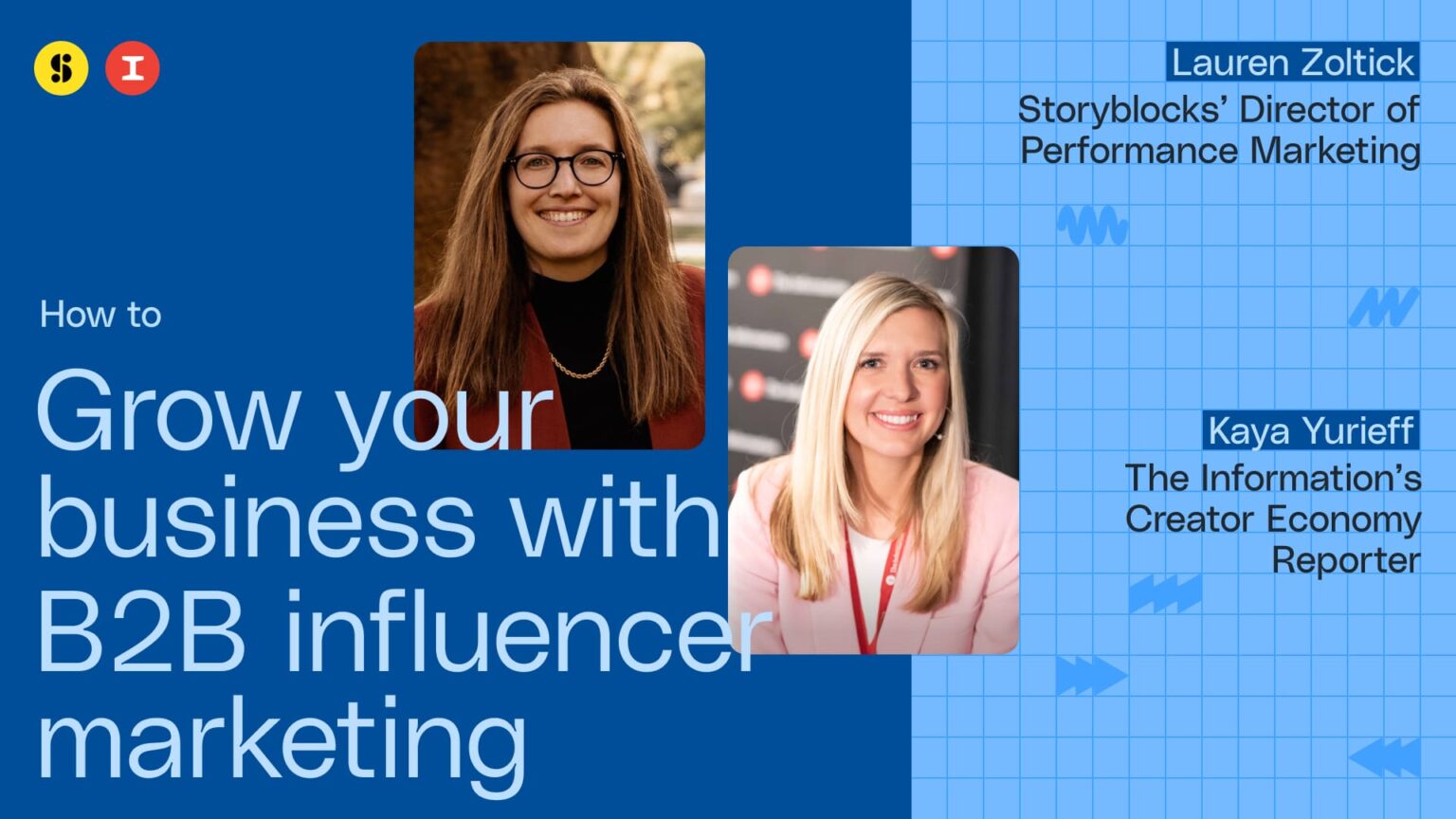Influencer marketing has historically been dominated by B2C brands looking to connect with their end customers directly. But there’s a big shift underway, and B2B influencer marketing has been surging as more brands enter the space.
For both B2B and B2C brands, influencer marketing can be a powerful tool for growing their business on top of traditional ads. When leveraged correctly, influencer marketing enables brands to reach their audience through a trusted source whose recommendations they want to hear. Influencer marketing has become a booming business, with spend in 2024 alone projected to hit $24 billion.
Kaya Yurieff is a creator economy and social media reporter for The Information, and is well tuned-in to trends in the space. She also runs a successful newsletter on the topic with more than 100,000 subscribers. In this post, we’ll cover how B2B brands can tap into the power of influencer marketing to drive awareness, increase intent, and grow revenue.
Kaya and Storyblocks’ director of performance marketing Lauren Zoltick chatted in depth about emerging trends and opportunities in the creator economy and influencer marketing. You can watch the entire webinar for free, or continue reading for the high-level takeaways.
Influencer marketing B2B examples and trends in 2024
Branching off the runaway growth of influencer marketing in the B2C world, influencer marketing for B2B has exploded in recent years. At its heart, the trend reflects a broader pattern of audiences trusting people for product recommendations, rather than faceless corporations. The rapid growth in the space has seen influencer marketing pop up in industries ranging from politics to sports. And it’s led to some interesting collaborations.
The NFL, for instance, has begun inviting creators to games to shoot footage. But not just sports-focused creators. Pro football is tapping into the popularity of lifestyle creators or food creators who make videos about how they tailgate. This gives fans a whole different perspective of the experience of attending a game.
The growth of influencer marketing has even reached the very halls of power in the United States. The Biden administration has invited creators to the White House for briefings on the Ukraine war and other pressing national topics. This being an election year, influencer marketing will give the candidates more opportunities to get their message out to voters. “I think we’re going to see creators really at the forefront of elections and just using their voices to support candidates,” Kaya says.
The diversity and volume of creators out there gives B2B brands the opportunity to tap into hyper-specific, niche audiences. No matter what product or service they offer. Kaya says she’s seen “everything from gardening to beauty products to backpacks for dogs” being marketed by micro-influencers. These influencers have smaller audiences, but their high degree of specialization draws a devoted fanbase. “I’ve talked to creators who just post about oatmeal, who just post about cheese boards. It’s so incredible how niche that’s gotten,” Kaya says.
Launching and approaching influencer marketing for B2B
While influencer marketing can help both B2C and B2B brands boost growth, the best approach to partnerships differs between them. What works for a strictly B2C audience might need some massaging before it’ll work in a B2B influencer marketing setting. Before signing with an influencer to help market your product or service, it’s a good idea to consider a few things first.
For starters, you’ll want to know if an influencer’s audience demographic aligns with the customers you’re trying to attract. If their audience skews very young, they might not be the right fit for a new piece of business software. For a brand looking to be edgier, an influencer who plays it a bit loose or uses profanity in their videos is more acceptable. Of course, any influencer you partner with should ideally be a fan of your brand and already using your product.
That said, don’t be too quick to judge a creator by the kinds of videos they make. Matches can sometimes be found in unexpected places. A fashion influencer who creates content around how she runs her business could have crossover appeal, for example. “So I wouldn’t discount, ‘oh, this is a fashion creator, or this is a food creator,’” Kaya points out. “Because all creators are entrepreneurs and have to run businesses.”
Getting your team on board with influencer marketing for B2B
Getting your team bought in on a B2B influencer marketing partnership can come down to perspective. Thinking of influencer marketing strictly as an extension of PR efforts or an earned media play works for some businesses. But here at Storyblocks, we view influencer marketing as a performance marketing channel, and even a revenue driver. We measure it that way, we track it that way, and we think about it that way.
You’re more likely to get that all-important internal alignment treating influencer marketing as a pipeline driver that can grow your business. With buy-in secured, you’ll be free to start testing small and build it out from there.
Best practices for effective B2B influencer marketing partnerships
To get the most out of your B2B influencer marketing partnership, it’s wise to familiarize yourself with some best practices.
1. Be very clear about the terms of your influencer contract.
Behind any B2B influencer marketing partnership is a contract that explicitly outlines what you’re asking for. The nuts and bolts of that contract are important, so consider them carefully. Be prepared to negotiate, and know in advance exactly what you’ll be asking your influencer partner to do.
For example, you should specifically outline which channels you’ll want them to create content for. Maybe your primary audience is on YouTube, but you’re trying to branch out to reach a younger TikTok crowd. If your influencer marketing partner will be cross-posting to other channels, it should be in your contract.
Another important consideration is exclusivity. If your B2B influencer marketing partner will be creating content exclusively for your brand, you can expect to pay more. This also applies if you plan on repurposing the content they create for other marketing materials. Ironing these specific terms out in advance will increase your chances of a fruitful partnership.
2. Remember that a influencer partnership should be a collaboration.
You’ll also set yourself up for success if you treat it like an actual partnership, rather than an employer-employee dynamic. Trust is at the heart of any successful partnership, and there’s no better way to build trust than by paying a creator what they’re worth. Especially if you want to work together long-term. “As a brand you’re trying to get a great rate for your marketing spend,” Kaya points out. “And as a creator, they’re trying to make as much money as they can and get the most value out of partnership.”
The best partnerships happen when the needs of both sides are considered and aligned. If you can’t come to an agreement on pricing, it might be best for everybody to move on. “Sometimes you don’t meet in the middle. Like sometimes there isn’t a rate that works for both of you, and that is ok,” says Kaya. “So it’s just about finding the ones that do work and the thing that works best for both of you.”
3. Let creative people be creative.
Another big part of trust in the influencer marketing dynamic comes from letting creative people be creative. You might have a crystal-clear vision of what you want an influencer partner to create. But remember that you chose a partner based at least in part on their creative style. After all, they built their audience and following based on the kind of content they create. Micromanaging breeds mistrust, and can stifle the “magic touch” that drew you to an influencer in the first place.
“The whole point of influencer marketing is that these creators have built so much trust with their audience and know how to speak to them,” Kaya says. So “if it feels like this kind of very polished ad, you’re not gonna get the engagement, people are just gonna keep scrolling.”
How to choose channels for B2B influencer marketing
In today’s content-driven marketing landscape, brands sometimes think they have to publish on every single platform out there. But when it comes to influencer marketing, a scattershot approach is often far less successful than a targeted campaign. Choose channels based on what you know about your audience demographics and how they align with a platform’s user base.
LinkedIn wasn’t much of a content destination until recently, but it’s become a hotbed for B2B influencer marketing. It all started when the platform “really started to embrace creators and embrace people sharing more,” Kaya says. Today, influencer posts about changing careers or treatises on office and job-seeking culture routinely rack up thousands of likes and reposts.
“I think people are treating LinkedIn much more as a social network, rather than a resume platform. So I think that’s one that could be really interesting for our B2B brands,” says Kaya.
Successful B2B influencer marketing examples
The best B2B influencer marketing partnerships feel organic, where the brand is a believable extension of the person or people promoting it. This is a lot easier to nail when brands partner with an influencer who really uses their product. Better yet, if they’re openly passionate about it.
Social media superstar Charli D’Amelio was well known in her videos for her love of coffee. Especially Dunkin’ Donuts coffee, which made regular appearances on her TikTok channel where she has 80 million followers. Dunkin’ eventually struck a partnership with the gen Z influencer, releasing several drink collaborations including “The Charli” which bears her name. “That led to a 57% increase in their app downloads on the day they launched the drink,” Kaya says of the partnership. “And then 45% increase in cold brew sales the next day, so you could really see the impact there.”
Miralax recently partnered for an ad with Ilana Glazer and Abbi Jacobson, co-stars of the hilariously irreverent “Broad City” TV series. In it, the duo reprise their roles, giving fans a taste of their favorite dysfunctional duo back in action. “I got on my Instagram and I was like oh my god, I missed the show so much, how did I miss this episode?” Lauren said of her experience encountering the spot in the wild. “I was like, this is the most natural integration. You could kinda tell about two minutes in that it was an ad, but like, barely.”
In both examples, the brands’ influencer partners had established trust with a large audience. By letting the creatives be themselves, only in a way that integrates their product, brands sparked a genuine audience connection. The spots were successful because they used familiar faces talking about a product in a relatable way to a targeted audience. Not just a faceless corporation pitching its product to anyone within earshot.
Final takeaways and considerations for successful B2B influencer marketing
You can set your brand up for success in B2B influencer marketing by following a few best practices.
First, be sure you’re treating your influencer marketing partner as a collaborator, not an employee. That’s the fastest way to make or break trust, a key component of building a strong relationship. Trust them to put their creativity to use, and try not to give more direction than absolutely necessary. Be precise in your contracts, clearly outlining everything you expect from your partner. Last but not least when it comes to trust, pay your partners what they’re worth.
Secondly, you want to make sure an influencer’s audience demographics align with your target audience. Your goal should be to create a campaign that feels natural. Consider your product, and the type of content your influencer partner creates. It will be obvious if the style or substance of their content is a total mismatch for your brand. Go with what feels right rather than committing to an idea at any cost that your audience won’t resonate with.
Last but not least, remember that audiences trust people, not faceless brands. Your goal in B2B influencer marketing should be to make your viewers feel seen. Treat your audience members like individuals, and cater to them accordingly with your influencer marketing partnership. The extra effort will pay off every time.
In today’s evolving business landscape, marketers face new challenges every day when trying to grow their audience. Watch the full webinar for more tips, and details on how B2B influencer marketing could be the missing piece of your strategy.



